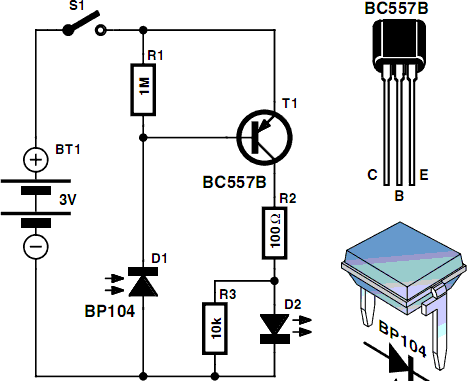IR (Infrared) Detector Circuit Diagram
Circuit diagram:
Circuit description:
Men in particular enjoy the convenience of television remote controls – often to the annoyance of their female partners. Men apparently want to know what they’re missing when the TV is tuned to a particular program, so they like to keep zapping to other channels. With the remote control in their hands, they feel like they are the lord and master of the TV set. They are thus completely at a loss if the remote control doesn’t work properly. There are many reasons why a remote control unit can malfunction, such as defective IR receiver in the TV set, a defect in the remote control, or empty batteries. Here a tester that can determine whether the remote control unit still emits an IR signal can come in handy. If you want to keep the IR reins firmly in hand, you can build your own IR detector.
If you have a few remote control units around the house, you’ll appreciate this little circuit. The LED clearly indicates whether the remote control unit actually emits an IR signal when you press one of the buttons on the unit. The circuit uses a photo-diode (D1) to sense the infrared light emitted by the remote control unit (if it is working properly). The plastic package of this diode acts as an IR filter that is only transparent to invisible light with a wavelength of 950 nm.
Although there are probably some remote control units that use IR diodes operating at a different wavelength, the circuit has enough sensitivity to detect them as well. If enough light falls on photo-diode D1, an electrical current will flow through the diode. In fact, what happens is that the leakage current increases, since photo-diodes are usually operated in reverse-biased mode (as is the case here). If the current is large enough, transistor T1 conducts and causes LED D2 to light up.
If LED D2 remains dark, this means the remote control unit is not producing any IR light. This can be due to an empty battery (or batteries) or a fault in the internal circuitry. Pay careful attention to the polarization of the photo-diode when wiring it into the circuit. The cathode is clearly marked by a special pin. For LED D2, use a low-current type that can handle a current of at least 7 mA. The detector can be powered by a pair of 1.5-V penlight cells connected in series.
circuit from http://www.extremecircuits.net/2010/04/ir-infrared-detector-circuit-diagram.html
